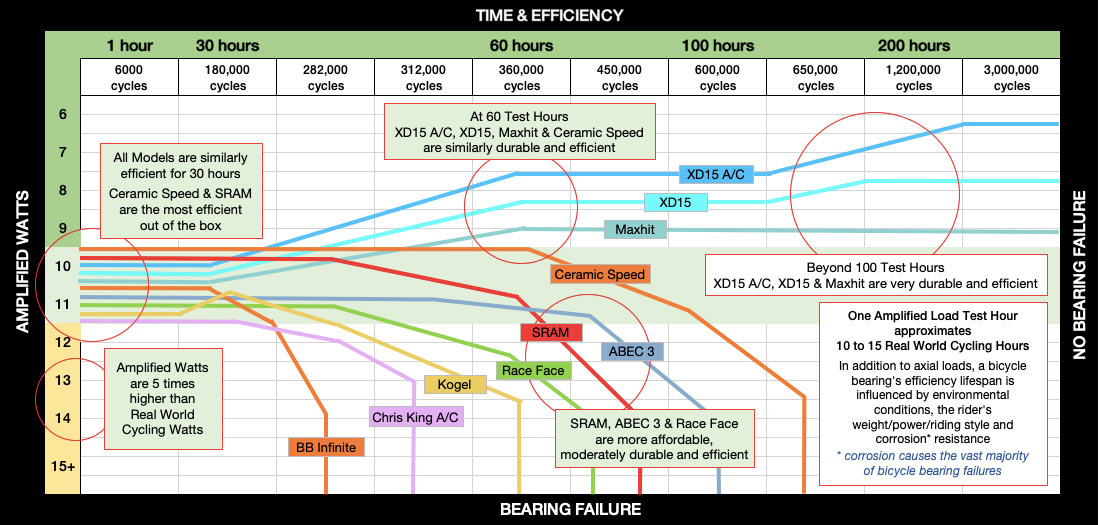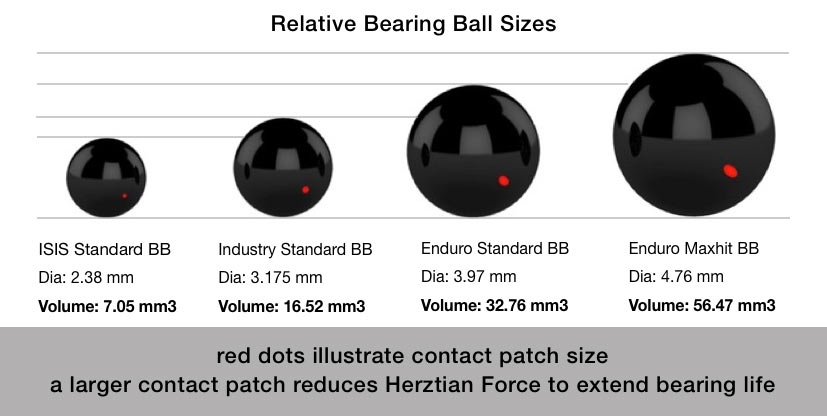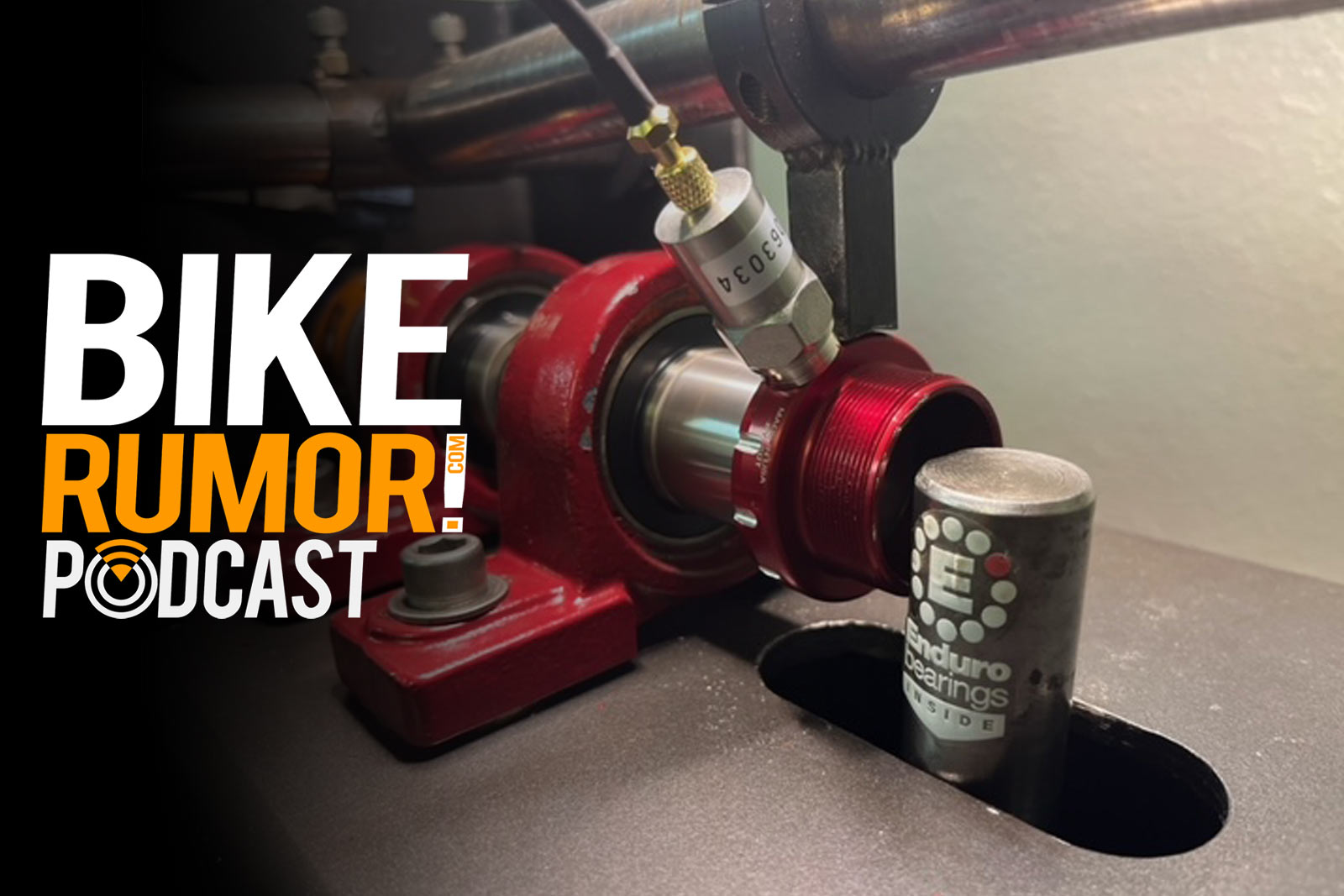I’m back with Matt Harvey from Enduro Bearings for round two, all about Bottom Brackets!
If you haven’t listened to our first chat, I recommend it as we go so deep down the rabbit hole of bearings that it’ll give you a lot to think about as you’re trying to optimize your bike.
In this episode, we focus on Bottom Brackets because Enduro recently released a report that shows the results of years of testing many popular brands of BBs, but the numbers need some explaining. You’ll find the charts and some interesting data below, along with a summary explanation to accompany the deeper dive in this interview.
Also in the interview are more fun facts about bottom bracket bearings, design, and materials…definitely worth a listen. Huge thanks to Matt for the added explanations!

At first glance, this chart makes it appear as though every other bottom bracket tested fails miserably, which isn’t the case. I spoke with Matt about this at Sea Otter and we agreed that an in-depth conversation about what these numbers really mean was in order.
Before you look at this chart and think that all of those other brands suck, let’s talk about the aspects that lead to the performance differences, and then further down I’ll show why this particular chart is visually misleading.
The full report is available for download on Enduro’s website, but here’s the gist of it:
- Bearing size matters most
- Bearing and Race material comes next
- Bearing design is last
Bearing Design
The reason bearing design is least important is because most brands use the same or extremely similar designs, and because you basically have only two options: Angular Contact, and Sealed Cartridge. The vast majority of brands use Sealed Cartridge and buy those from a small pool of 3rd parties (sometimes Enduro!), so they’re mostly interchangeable with the exception of Enduro’s MaxHit, which use a custom, much deeper channel for the balls to roll in.
Angular contact is, theoretically, better, but much harder to setup and maintain, and for most users, the added work and risk of doing it wrong isn’t worth it. We explain why in the podcast.

Bearing & Race Material
Enduro’s XD15 material combined with ceramic balls is basically the longest lasting combo you can get, at least of those tested, but also pretty much overall.
Chromium Steel is the least expensive and most likely to corrode, so it requires the most maintenance. It will wear extremely quickly if water, dust or other contaminants get in there.
440C Stainless is a softer steel than the XD15 but still good, however bearing size plays a massive role in its durability.

Bearing Size
Simply put, bigger balls roll more slowly, which means lower wear, and they have a larger contact patch, which means better ability to handle higher loads.
Bearing Design…again
So, actually, with regards to fitting bigger balls into a bearing, design matters a lot. Enduro’s MaxHit products use the shell of the product as the outer race, which frees up room for bigger balls.

Depending on the combination of bearing size and material selection, combined with the conditions you ride in and your maintenance efforts, a bottom bracket’s durability can go from weeks or months to a decade. Yes, Enduro has had customers putting in thousands of miles per year for a decade on the same bottom bracket.
Now, back to that chart…

New bearings, no matter which ones, will typically contribute about 0.25 watts of drag to a bike. Added all up in your drivetrain, it’s maybe 2-3 watts total, excluding seal drag. It’s not much.
Which is why the numbers above threw me at first. On the left are AMPLIFIED watts, not actual watts. And that’s because Enduro had to amplify the readings by 12x in order to see a difference…because power meters simply aren’t sensitive enough to measure small fractions of watts.
If we were looking at actual wattage differences, the chart would look more like this:

The actual wattage difference between bottom brackets from the best case to the point just before failure is around 0.7 watts. Now, when it fails, it fails, but as long as the bearings are kept clean and greased, the difference in DRAG is going to be minimal.
That doesn’t necessarily mean they won’t develop play and feel a little sloppy, but they won’t gain much drag…until they fail.
The misleading number on the chart is the lifespan. The test was conducted with a 360º load on the bearings, but in reality, BB bearings are only about 1/3 loaded (on the bottom) when we’re pedaling. So, that’s a 3x over reality.
Next, the load on the bike was equivalent to a 480lb rider putting out a consistent 600 watts, which averages somewhere around 4x the load put onto the bearings by a typical rider.
So, if we look at even the worst performing BB on the chart failing at ~35 hours and multiply by the loads, that’s:
35 x 3 x 4 = 420 hours at 100rpm
420 hours is 210 days of 2 hour rides, which is at least a couple years worth of riding for most of us. So while it may look like some brands fail much sooner than others, the reality is that all of them last a really long time.
Why geek out on this?
Well, if I’m being honest, I’m friends with every brand on that list. So when I first saw this, I’m thinking “Crap, they’re all going to hate me if I publish that chart.” But the more I looked at it, the more questions I had. Ultimately, just sharing the raw chart would do a disservice to you and the other brands, so I wanted to put it into perspective.
Enduro has a lot of comments in the report for each brand, explaining why they think some did better than others. Between this post, that report, and the podcast interview, I hope you’ll get a better understanding of BBs and bearings and not be afraid to question what you see. I’m glad I did, and glad Matt’s always keen to share his experience.
This episode sponsored by:

Spring is the perfect time to upgrade your ride. From top brands to niche names, TPC has a curated selection of new and Certified Pre-Owned bikes for every discipline. Each Certified Pre-Owned bike is inspected, tested and serviced by expert mechanics, and every bike includes risk-free 30 day returns. Visit theproscloset.com/bikerumor and enter code BRPODCAST to save $40 on every order over $200.
Want More?
Find the BikeRumor Podcast on Apple Podcasts, Stitcher, Podbean, and through RSS, or wherever you listen to podcasts! Hit like, hit subscribe, and hit play! Can’t find it? Let us know which players you use so we can get them up to speed! And let us know who you want us to interview, just use this form to send us your suggestions!
FOLLOW BIKERUMOR
Keep tabs on all the latest bikes, wheels, components, gear, and tech on The World’s Largest Cycling Tech Blog by following us on Facebook, Twitter, and Instagram.
FOLLOW TYLER
Like us? Love us? Follow your host, Tyler Benedict, on Twitter, Instagram, and LinkedIn.
